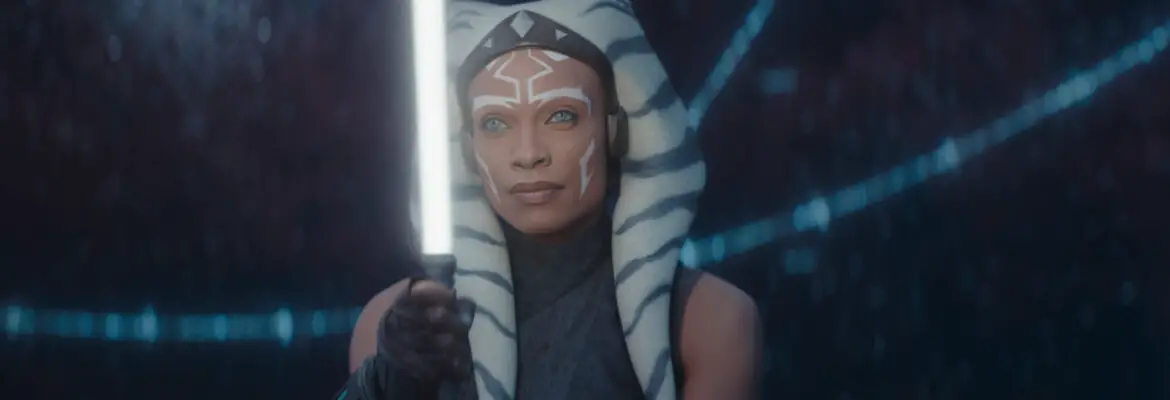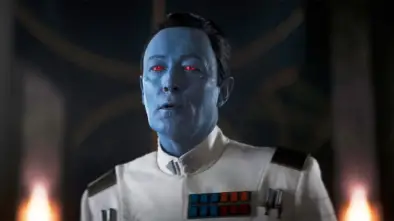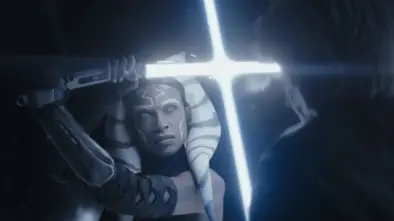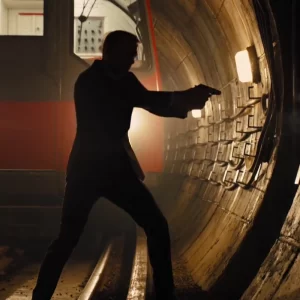Does Ahsoka Episode 4 Mark A Positive Turning Point For The Series?
Ahsoka Part 4 improves on the first three episodes but this show feels like a practice run for a beginner screenwriter not someone like Dave Filoni.
In Ahsoka Part 4, Ahsoka and Sabine try to stop Baylan from transmitting the new galaxy’s coordinates into the navigation system of the Eye of Sion, Morgan Elsbeth’s hyperdrive ring.
Master and Padawan engage Marrok, Baylan, and Shin in multiple lightsaber duels. Ahsoka destroys Marrok. But she is defeated by Baylan. Due to her attachment to Ezra, Sabine hands over the star map to Baylan and is taken on board the hyperdrive ring.
Hera arrives with a detachment of X-wings. But her blockade doesn’t prevent the hyperdrive ring from zooming into hyperspace. The episode ends with Ahsoka waking up in the World Between Worlds and seeing the familiar face of her former Master, Anakin Skywalker.
“Part 4- Fallen Jedi” improves on the first three episodes. But the bar was already set pretty low. Let’s face it the first three episodes were dull. Nothing of importance happened, all the characters were stoic to the point of being living statues, and the mystery surrounding Thrawn and Ezra Bridger’s location in another galaxy has been boring. No tension. No stakes. Just a waste of time really.
In Part 4, at least, the plot moves at a decent pace, with well-choreographed and well-edited fight scenes, and a better soundtrack than in earlier episodes. And, for once, there are some good character moments that reveal the motives and personality of characters, some at least.
But let’s not get too carried away. There are still more problems with this series than can fill a Star Destroyer. Before we delve into the improvements this episode has made, let’s list the main grievances:
- The continual stupidity of characters. Two egregious examples are (1) Why does General Hera Syndulla take her young son, Jacen, into battle? She already said in previous episodes that she wants to protect Jacen from becoming a Jedi like his deceased father. Would he not be safer back on the biggest ship in the High Republic fleet? (2) During the first lightsaber duel, Shin uses a smoke grenade to disorientate Sabine. She clearly has the upper hand and could have easily cut Sabine down. Instead, she chooses to run away. Obviously, the screenwriter wants Jacen to accompany Hera to this new galaxy, and Shin spares Sabine’s life because, well, Sabine needs to stay alive to serve the plot.
- Morgan Elsbeth. What is the purpose of this character? Clearly, Lord Baylan works for Thrawn. He doesn’t need Elsbeth to get the coordinates for the ring and travel to this new galaxy. I guess he needs a Girl Boss to tell him what to do. I have no problem with female authority like Mon Mothma, though Ahsoka has already made her characteristically weak in episode 3. But Elsbeth, who had a promising beginning in The Mandalorian “Chapter 13-The Jedi”, serves no purpose here and has had zero character development. Walking around with a permanent scowl on one’s face is a poor substitute for characterization. She’s apparently a Nightsister, which is a name for a Force witch from The Clone Wars. But none of this lore is mentioned. Instead, she is called a witch, a term which along with her name, Morgan Elsbeth, makes her sound like a sorceress from the Scottish Highlands, rather than in Star Wars.
- The Lost Star Map trope. We’re halfway into this series, and all the first four episodes have been about finding and using the star map that leads to a new galaxy. Apart from the obvious problems with this apparently indecipherable map being easily decipherable by a casual viewer sitting on their couch at home, this is a tired old trope that Disney continually trots out. For example, The Force Awakens spent most of its time trying to find a missing part of a space map that leads to Luke Skywalker. All this does is keep the more interesting characters off-screen for most of the plot. This leads to the next problem:
- Thrawn has been off-screen for too long. You don’t keep your main villain off-screen for four episodes (and counting). Thrawn is easily the best villain in Star Wars since Darth Vader and Emperor Palpatine. In Timothy Zahn’s Thrawn novels, the character is a step ahead of Emperor Palpatine and closes his mind so Vader can’t read it. Thrawn is a clever character who is manipulative and deliberate like Machiavelli and observant like Sherlock Holmes using deductive reasoning to win against rivals within Imperial ranks, find traitors, and uncover Rebel and New Republic plans.
- The continual homage to the original trilogy is too on the nose. When Hera leaves the fleet and zooms into hyperspace with her detachment of X-wings, there is an instant feeling of deja vu. That’s because it recalls the fleet’s jump to hyperspace in Return of the Jedi. Then Hera’s comment to “cut across the axis” of the hyperdrive ring is an exact ripoff from Red Leader when the Rebels first engage the Death Star in A New Hope. And the hyperdrive ring is a clear placeholder for the Death Star. It just feels like the filmmakers are struggling to make this show feel like Star Wars so they just continually riff on the original trilogy. These callbacks are loaded into all four episodes and the sheer number of them makes the show feel like bad karaoke.
Nonetheless, as I’ve said, there are some good things at work here, especially the big reveal at the end which hopefully sets up the serious lore-building Dave Filoni did in The Clone Wars and Rebels.
Okay, let’s talk about the positives.
The Gravitas of Ray Stevenson

Image: Lucasfilm
Sorry Ahsoka, but Baylan Skoll, played by the late Ray Stevenson, is the best character in the show. He’s a complete scene stealer. There is something that older British male actors have over everyone else: gravitas. The gravitas that exudes effortlessly from great British actors like Alec Guinness and Liam Neeson has been sorely lacking in Disney Star Wars, until now.
The sight of Baylan standing in an old henge while wielding his lightsaber like a broadsword and wearing armor that would not be out of place on an old knight in an Arthurian legend taps into the best aspects of mythic storytelling.
In fact, this has been a feature of the best episodes in Disney Star Wars. Dave Filoni and Jon Favreau, the architects of the Mandoverse, have delved into the samurai, Western, and Arthurian stories just a little bit more literally than George Lucas did. The result is mixed. The worst is Morgan Elsbeth’s Scottish sorceress who feels out of place in Star Wars. Using a medieval knight as the basis for Baylon Skoll, however, works. He’s from an older order of Jedi Knights already established in Star Wars lore by George Lucas.
Influence of Akira Kurosawa’s Samurai Films
Apart from Baylan channeling an old English knight, this episode feels very much like the old samurai movies by Akira Kurosawa, which inspired Lucas.
This is the second Disney Star Wars episode that is so blatantly inspired by Kurosawa. The first is the live-action introduction of Ahsoka Tano in an episode entitled “Chapter 13: The Jedi” from season 2 of The Mandalorian.
Both episodes are atmospheric. The sight of Ahsoka suddenly appearing out of the thick green fog to dispatch henchmen with a few quick flashes of her white sabers as she works her way up to face Morgan Elsbeth at her fortress was worth the price of subscription to Disney+.
Now, in episode 4 of Ahsoka, our heroes face off against their foes under the red canopy of a forest, which recalls the cherry blossoms of Japan–a frequent location for death matches between samurai.
Well-choreographed and Well-Edited Fight Scenes

Image: Lucasfilm
The lightsaber battles under the hooded beauty of the forest and later at the henge finally look like they’re choreographed by an actual swordsman.
The fight scenes are also edited better than previous episodes. The editor clearly studied what made these scenes work in the original and prequel trilogies.
Like the original trilogy, the editor cuts back and forth between Sabine and Ahsoka’s lightsaber fight scenes. When cutting back and forth between the two fight scenes, the editor cuts away right at a crucial moment, when you want to see something happen, when you expect the adversary to have the upper hand. This editing technique brings in much-needed suspense, with a momentary cliffhanger that helps invest you in the fight.
Real Characters With Foibles and Vulnerability
Ahsoka has curbed Disney’s tendency to portray women as Mary Sues born with every skill they need–no training needed. This is no more apparent than in the re-match between Shin and Sabine after Shin skewered Sabine within an inch of her life at the end of episode one (a source of a well-deserved concern from fans opining the fact that people normally die when impaled by a laser sword).
Still, here, we get to see Sabine stumble to the far superior skills of Shin Hati. Sabine has no connection with the Force but her skills with a lightsaber come from fighting skills she developed as a Mandalorian.
Sabine uses her disability with the Force as an advantage, though. She holds her hand up as if to use the Force on Shin, who laughs at her lack of power. Sabine has a literal trick up her sleeve, though, when she fires a blast from her wrist which takes Shin by surprise and allows Sabine to escape uninjured.
Meanwhile, Ahsoka betters Marrok with her well-timed skill with her blade. But she finds that she is overpowered by Lord Baylan later at the henge. She finds it difficult to deflect his powerful blows, but it is really after she is weakened by grabbing the star map and her attachment to Sabine’s well-being that causes her to be defeated. A powerful blow from Baylan’s saber sends her over the cliff edge into the ocean waves below.
It’s good to see the main protagonist get beaten. You know there will be a re-match, but the story is far more interesting when the main character can experience defeat. It just makes their comeback that much more powerful in the climax of the story.
Action Reveals Character (And Attachment Leads to Defeat)
The pace is fast, and the action keeps the story moving forward. And the fights have real impact on character.
Here, action reveals the character of each participant. Sabine’s struggle to use the Force makes her more relatable as a character. But Sabine also uses guile to defeat or escape a superior enemy. Ahsoka’s stoicism in earlier episodes breaks when Sabine is in danger. It’s a front. She cares for Sabine. But her attachment leads to her defeat. The Jedi warn against attachment in almost every film and TV series, and it’s a warning Ahsoka has not learned to heed with Sabine. There’s some history between the two yet to be explored.
This theme of attachment carries through to Sabine and her relationship with Ezra Bridger. Rather than destroy the map so no one can find Thrawn, Sabine can’t risk losing Ezra who is lost with Thrawn in this other galaxy. Baylan promises to help her find Ezra. So she hands him the star map, which he uses to finish uploading the coordinates of this new galaxy to Morgan Elsbeth’s hyperspace ring.
Sabine’s choice could have devastating consequences for considerably more people than just her and Ezra.
Adversaries That Believe They Are Good
Baylan Skoll, who has the best characterization in the series so far, is not a mustache-twirling villain. He believes his actions are for the greater good. He believes that what he is doing is right.
More than that, he sees Ahsoka as a villain. In one moment as the two cross lightsabers, Skoll tells Ahsoka, “Your legacy, like your Master’s, is death and destruction.”
He sees her as another corrupted Jedi, an order he chose to leave.
Baylan clearly has a code. When Shin tries to Force choke Sabine, Baylan tells her, “Let her go. I promised her that she will come with us. And unlike her former master, I keep my promises.”
Baylan’s an interesting character, and it’s not exactly clear which side he will fall on in the end.
Dave Filoni’s Serious Lore Building
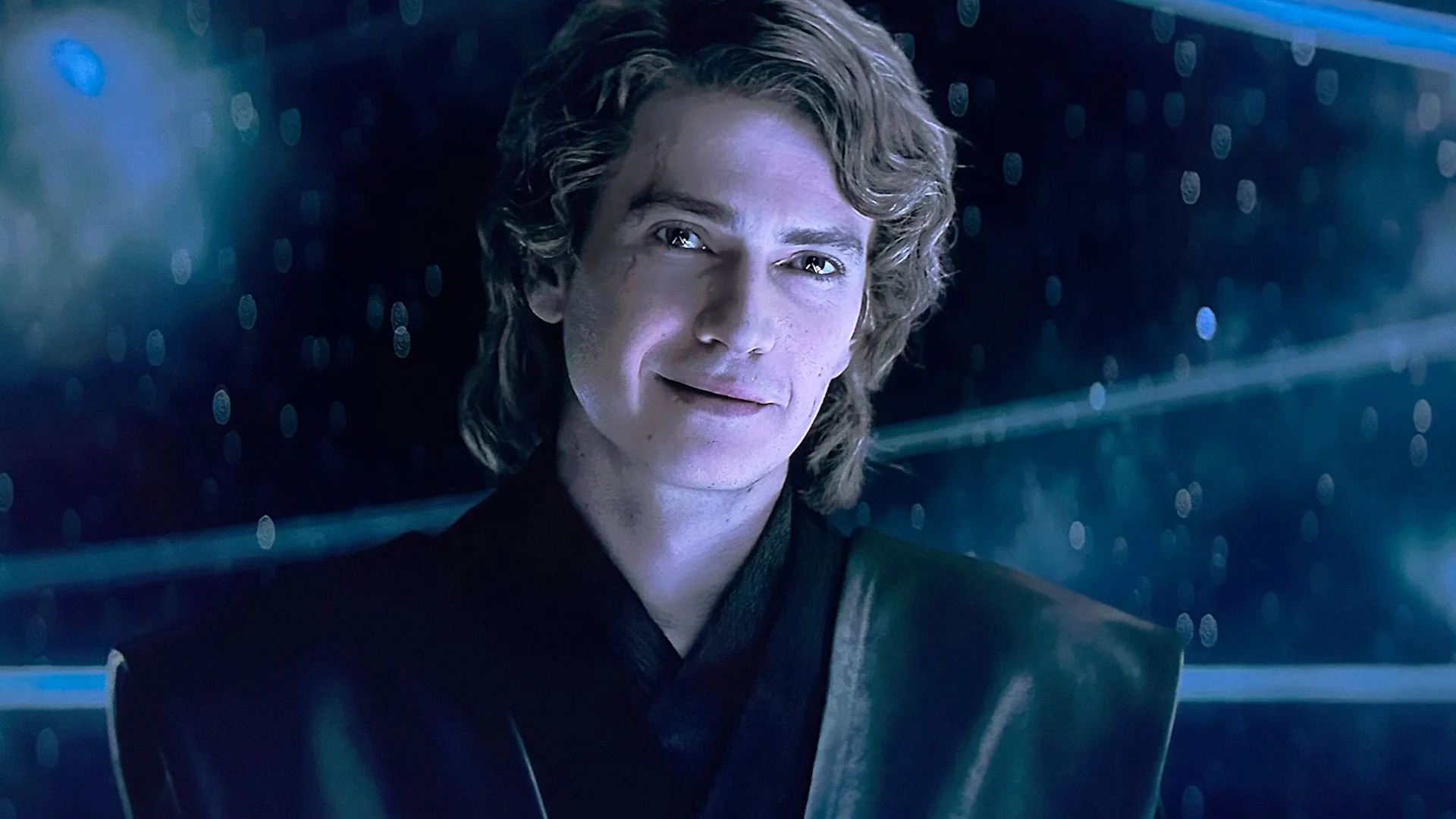
Image: Lucasfilm
While there have been numerous connections to the prequels, the original trilogy, and Dave Filoni’s The Clone Wars and Rebels TV series, nothing prepared fans for the final scene in Episode 4.
Ahsoka wakes up the World Between Worlds and turns to see her old Master Anakin Skywalker smiling back at her. This is the first time we see Hayden Christensen interact with Ahsoka Tano. He never voiced his character in The Clone Wars animated series. So it was great to hear him refer to Ahsoka as “Snips”, which is Anakin’s nickname for her.
The introduction of the World Between Worlds in live-action raises many questions. This is the realm that only a few living Jedi could access. We’ve only seen Ezra Bridger enter, and in Rebels, he pulled Ahsoka into this realm during her duel with Vader, effectively saving her. From there, Ahsoka journeyed through the World Between Worlds and emerged changed as Ahsoka the White, a nod to Gandalf the White in Lord of the Rings.
So why is Anakin there? Is this where Force Ghosts reside and do they use the portals within this realm to appear to the living? Or is his presence here somehow related to the Mortis gods and the prophecy of the “Chosen One” that Filoni delved into in The Clone Wars?
Many believe this is the beginning of redemption for Anakin Skywalker and a bigger role for Hayden Christensen in future Star Wars episodes.
We all knew that the World Between Worlds would feature in Ahsoka since it is part of the show’s logo. But, nonetheless, Anakin’s presence there is mystifying and has opened up a huge range of possibilities in Star Wars lore.
Episode 5 is expected to focus on Anakin, so expect some answers to this mystery when it is released on Tuesday, September 12 at 9 p.m. EST on Disney Plus.

